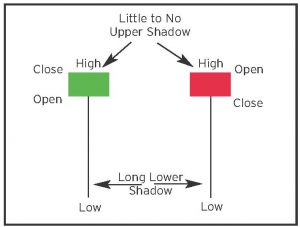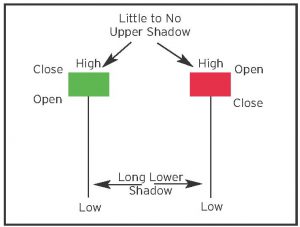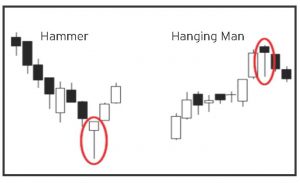Market side: Futures trading basics
LESSON 35: TECHNICAL ANALYSIS

CANDLESTICK CHARTING
This lesson we will continue to explore basic candles.
HAMMER AND HANGING MAN
If I had to guess which candles rank in order of importance after the doji, I would have to say it is the combination of the hammer and hanging man. It is easy to confuse these two candlesticks because they look identical. However, one is bearish, while one is relatively bullish.
Both the hanging man and hammer are trend reversal candles and have a very long shadow and a very small real body. Typically, they have no upper shadow (or at the very most, an extremely small one). To be an official hammer or hanging man, the lower shadow must be at least twice the height of the real body. The larger the lower shadow, the more significant the candle becomes.
How can you tell the two candles apart? Basically, it depends on the trend that they appear in. If the trend has been moving higher and the candle appears, it is called a hanging man. If, on the other hand, the candle appears after an extended down move, it is known as a hammer. The colour of the candle in this case is not important.


On the day of the hammer candle there is strong selling, often beginning at the opening bell. As the day goes on, however, the market recovers and closes near the unchanged mark, or in some cases even higher. In these cases, the market potentially is “hammering” out a bottom.
Here is an example of a hammer and a hanging man candle as they appear on the chart:

As with all candles, the ‘rule of two’ applies. That is to say, a single candle may give a strong message, but you should always wait for confirmation from another indicator before taking any trading action. It may not be necessary to wait an entire trading day for this confirmation. When it comes to the hanging man, for example, confirmation the next day should at least include closing the real body of the hanging man candle. Another possibility would be a gap down in prices. With the hammer, a gap opening would be a strong confirmation of the hammer. •
| Lesson Definitions: Hammer: the Japanese name for the hammer pattern is takuri, which means testing the water for its depth. The hammer pattern is the same one as the hanging man pattern but it occurs in a downtrend and is a bullish signal that warns of a possible trend reversal. The candlestick is called a hammer because it hammers out a base at the bottom of the downtrend. The long lower shadow of the hammer is a bullish signal regardless of the colour of the candlestick’s real body; although I prefer to see a green or clear real body. The hammer indicates that the underlying sold off sharply but demand returned, forcing the price back up to close at or near the high for that period. |
Marty Hibbs is a 25 year veteran futures trader, analyst, and portfolio manager. Hibbs was a regular guest analyst on BNN for four years. He is currently a grain merchandiser with Grain Farmers of Ontario.
DISCLAIMER: This information has been compiled from sources believed to be reliable, but no representation or warranty, express or implied, is made by the author, by Grain Farmers of Ontario, or by any other person as to its accuracy, completeness or correctness and Grain Farmers of Ontario accepts no liability whatsoever for any loss arising from any use of same.
























